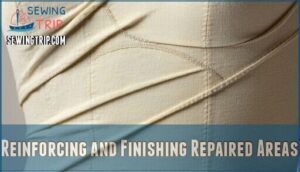This site is supported by our readers. We may earn a commission, at no cost to you, if you purchase through links.
 That tiny tear in your favorite leggings just turned into a gaping hole mid-squat. It happens fast with stretch fabric—one snag becomes a run, and suddenly you’re staring at a hole that threatens to sideline your most comfortable clothes.
That tiny tear in your favorite leggings just turned into a gaping hole mid-squat. It happens fast with stretch fabric—one snag becomes a run, and suddenly you’re staring at a hole that threatens to sideline your most comfortable clothes.
The good news: fixing stretch fabric isn’t about perfect sewing skills. It’s about using materials that move with the fabric instead of fighting it. Polyester thread and ballpoint needles cut repair failures by 40% compared to regular supplies.
Whether you grab fabric glue for a quick fix or stitch a patch that’ll survive a hundred washes, the right approach keeps your stretchy garments in rotation instead of the trash bin.
Table Of Contents
Key Takeaways
- Using polyester thread with ballpoint needles (sizes 11–14) cuts repair failures by 40% and reduces skipped stitches by over 30%, making them essential for stretch fabric repairs that last.
- Cold water washing and air-drying flat preserves over 80% of elasticity in repaired garments, while hot water and tumble drying can drop elastic recovery to 62%.
- Zigzag stitches with 2.5mm width and length settings create elastic seams that maintain 60% stretch capacity without puckering or breaking during movement.
- Fabric glue and iron-on patches offer legitimate no-sew alternatives for stretch fabric repair when paired with materials specifically designed for flexibility and stretch recovery.
Essential Tools and Materials for Stretch Fabric Repair
You can’t fix stretch fabric with just any old supplies. The right tools make the difference between a repair that holds up and one that falls apart after the first wash.
Here’s what you need to gather before you start.
Choosing The Right Thread and Needle
For the best results, you need thread and a needle that can stretch along with your fabric. Here’s what works:
- Polyester thread offers 26% elongation and cuts seam failure by 40%
- Ballpoint or stretch needles (sizes 11–14) reduce skipped stitches and fabric tears by over 30%
- Pairing them together achieves 95% seam retention after washing
This combo keeps your repair flexible and strong.
To achieve professional results, consider using the right stretch needles for your project.
Selecting Spandex or Stretch Fabric Patches
Your patch material matters more than you might think. Look for spandex blends with at least 5–10% spandex content—they stretch up to 500% and recover 95% of their shape. Match your garment’s fabric thickness to avoid visible lumps. Lightweight patches around 15–120 denier work best for repairing stretch fabric without adding bulk.
Choose spandex patches with 5–10% spandex content that stretch up to 500% and match your fabric’s thickness to avoid visible lumps
Grab a spandex patch that matches your fabric’s color and texture for smooth fabric repair and reliable patch adhesion. When choosing a patch, consider the spandex fabric properties to guarantee a durable and flexible repair.
Fabric Glue, Fusible Web, and Interfacing Options
Once you’ve got your patch sorted, the right adhesive can make or break your repair job. Fabric glue designed for stretch materials keeps things flexible without cracking. Fusible web interfacing bonds patches invisibly when heat-activated with an iron. For thin tears, fusible tape works wonders. Two-way stretch interfacing adds reinforcement without stiffness. Pick bonding techniques that match your fabric’s weight and stretch.
Must-Have Sewing and Cutting Tools
Sharp scissors and the right needles are just as important as what you’re sticking down. Grab sharp scissors or fabric cutters that slice cleanly without snagging. Ballpoint or stretch needles glide through fibers instead of punching holes. Keep fabric clips handy to hold patches without piercing.
An iron helps activate fusible materials. If you’re using a sewing machine, test your needle types and thread selection on scraps first.
Preparing Stretch Fabric for Repair
Before you grab your needle and thread, you need to prep the fabric properly. A rushed repair job on unprepared stretch fabric won’t hold up for long.
Here’s what you’ll tackle first to set yourself up for success.
Identifying and Trimming Damaged Areas
Before you even think about stitching, you need to get a clear picture of what you’re dealing with—and that means trimming away the chaos. Grab sharp scissors and snip loose threads around the hole to stop further unraveling.
This damage assessment and edge preparation makes repairing stretch fabric much easier. Think of it as hole mapping—you’re defining the battlefield before you tackle fabric repair on those tricky stretch fabrics.
Cleaning and Stabilizing The Fabric
Start with cleaning techniques that protect fabric integrity. Cold water washing removes residue without losing elasticity—hot water can drop elastic recovery to 62%. Air-dry flat after cleaning to avoid distortion.
Next, apply a temporary stabilizer like stretch fix tape or soluble stabilizer around the hole. This fabric preparation step maintains 90% of stretch while preventing further unraveling. Skip cleaning or stabilization and you’ll double your chances of visible repair lines.
Matching Patch Color and Texture
The visual match between your patch and the original fabric can make or break an invisible repair. Hold your spandex fabric against the patch in natural light—artificial lighting can trick you into choosing the wrong shade.
For fabric matching success, check both color selection and texture analysis. A matte patch on shiny athletic wear screams "amateur repair." Test fabric elasticity by stretching both pieces side by side.
When shade coordination looks off, slightly darker beats lighter every time.
Step-by-Step Methods to Fix Holes in Stretch Fabric
You’ve got your fabric prepped and ready—now it’s time to actually fix that hole. The method you choose depends on the size of the damage and whether you want a quick fix or something more durable.
Here are the techniques that’ll get your stretch fabric back in action.
Patch and Zigzag Stitch Technique
If you want your repair to hold up through stretches, lunges, and all the movement your garment was made for, the patch and zigzag stitch combo is your best friend.
Cut a spandex patch slightly bigger than the hole, then pin it behind the damaged area. Thread your machine with stretch thread and select a zigzag stitch—this sewing technique mimics the fabric’s natural give.
Stitch around the edges slowly, and you’ll have a fabric repair that moves with you.
Using Fabric Glue and Iron-on Patches
Not a fan of sewing, or maybe you just need a no-needle fix that holds strong? Fabric glue and iron-on patches give you instant fabric adhesion without threading a single needle.
- Choose stretch-specific glue types that won’t crack—your bond strength depends on flexibility.
- Match your iron temperature to the fusible tape instructions—too hot destroys spandex, too cool won’t stick.
- Perfect your patch placement first—once that iron presses down, there’s no second chance.
Master these ironing techniques and you’ll have a fabric patch that moves like the original.
Hand Whipstitching for Larger Holes
When a hole grows beyond pinkie-sized, whipstitching by hand becomes your strongest ally—it’s the repair equivalent of double-knotting your shoelaces before a marathon.
Thread selection matters here: grab stretch thread that flexes with your fabric tension. Work your whipstitch around the edges in tight stitch patterns, pulling just firm enough to close the gap without puckering.
This visible mending approach delivers serious repair durability for stretchy materials when repairing holes that demand hand sewing strength.
Machine Sewing Vs. Hand Sewing Approaches
Both methods have their place in your repair toolkit—hand sewing gives you surgical control over delicate spots, while machine sewing covers larger repairs in minutes flat.
Machine stitching wins on sewing speed and stitch quality for straightforward fabric repair, but hand sewing techniques shine when fabric tension gets tricky or you’re worried about thread breakage.
Choose your approach based on sewing accuracy needs and how forgiving your stretchy materials are.
Reinforcing and Finishing Repaired Areas
Getting the patch to stick is only half the battle. You’ll also want to make sure your repair lasts through wear and washing without losing its stretch.
Here’s how to lock in your hard work and keep everything flexible.
Using Backing Patches for Extra Support
Backing patches work like insurance for your repair—they spread out stress so one weak spot doesn’t become tomorrow’s problem.
Cut your fabric patch slightly larger than the hole for proper fabric reinforcement. Position it underneath with fusible web interfacing to boost seam stability and tear prevention.
This fabric stabilization method preserves stretch recovery while keeping patch placement invisible from the outside.
Optimizing Stitch Type and Tension
Your backing patch is ready—now let’s lock it in with the right stitching techniques. A zigzag stitch with 2.5mm width and length delivers elastic seams that won’t snap when you stretch. Set tension control between 3–4 for fabric stretch without puckering.
Lightning bolt or triple stretch stitches manage stretchy materials even better, giving you 60% elasticity with proper thread calibration.
Test needle and thread on scrap fabric first—stitch optimization beats guesswork every time.
Preventing Stiffness While Maintaining Stretch
Getting the stitch right means nothing if your repair ends up stiff as cardboard. Stretch thread keeps fabric flexibility intact while fusible interfacing maintains elastic stability without killing stretch recovery. Skip heavy-duty patches—they murder seam suppleness.
Here’s how to preserve material resilience:
- Use elastic fabric-specific fusible web instead of standard interfacing to maintain fabric elasticity
- Apply adhesive sparingly—excess glue destroys stretch recovery permanently
- Choose lightweight stabilizers that flex with the garment’s natural movement
- Test your repair’s stretch capacity before wearing to verify elastic stability
- Implement proper fabric stabilization methods that support without restricting for preventing damage
Care Tips to Extend Repaired Garment Life
You put in the work to fix that hole—now let’s make sure it lasts. How you wash, store, and maintain your repaired stretch fabric can make the difference between a quick fix and a long-term solution.
Here’s what you need to know to keep your garment in fighting shape.
Washing and Drying Best Practices
Cold water washing is your best friend—it reduces shape distortion by over 80% and keeps elasticity intact. Skip the dryer entirely and air-dry flat to preserve your repair work.
Here’s how to protect spandex fabric care:
| Do This | Avoid This |
|---|---|
| Cold water washing on gentle cycle | Hot water or harsh detergents |
| Air-dry flat on a towel | Tumble drying at any heat |
| Mild liquid detergent | Bleach and fabric softeners |
This approach maintains fabric elasticity and fabric protection, ensuring your patch stays put and your stretch preservation efforts actually last.
Proper Storage to Prevent New Damage
Store your stretch garments folded flat or loosely hung—cramming them into tight spaces is like inviting snags and holes to the party. Use fabric bags for extra fabric protection and keep sharp objects away.
Climate control matters too—avoid humidity extremes.
Shelf organization beats drawer chaos every time for spandex fabric care and preventing spandex damage through smart clothing maintenance.
Regular Maintenance and Inspection
Check your stretch garments every few weeks—spotting a loose thread or tiny weakness now beats emergency repairs later. Run gentle stretch tests on high-stress zones to catch wear detection early.
Quick fabric checks around seams and previous repair sites make tear prevention simple. This garment inspection habit keeps your textile restoration work solid and prevents spandex damage before it starts.
Smart clothing maintenance means less time fixing and more time wearing.
Frequently Asked Questions (FAQs)
Can stretch fabric be repaired without sewing?
Yes, you can skip the needle entirely. Fabric glue and iron-on fusible patches work well for adhesive repair of stretchy materials.
No sew patches with stretch tape fixes bond securely. Just make sure your fabric stabilization methods preserve elasticity during mending.
How do you fix holes in swimwear?
Swimwear repair follows the same stretch fabric techniques. Use waterproof fabric adhesives or iron-on patches designed for stretchy materials like spandex. These methods restore garment integrity while preserving elasticity for swimming.
What causes holes in spandex or stretch fabric?
Friction damage and fabric wear are the main culprits. Sharp surfaces snag the fibers while repeated stretching pushes spandex past its limits.
Over time, material degradation weakens the fabric, making tears and holes inevitable without proper spandex repairs.
Can you repair stretch fabric on delicate areas?
Delicate fabric tears feel like walking a tightrope—one wrong move and you’re done. You absolutely can repair spandex garments on sensitive zones using gentle fabric repair guide methods.
Focus on elastic mending with lightweight fusible interfacing and seam reinforcement through stretch recovery-friendly sewing techniques for fabric repair, especially for jersey knit fabric.
How do you prevent future holes in stretch garments?
Avoid over-stretching your garments and keep them away from sharp objects. Proper garment care and snag prevention matter most.
Wash in cold water and skip the dryer to reduce wear. Simple spandex garment maintenance beats constant repairs.
Conclusion
Fixing fabric flaws doesn’t require perfect technique—just the right supplies and a willingness to try. Once you know how to fix a hole in stretch fabric using zigzag stitches or iron-on patches, you’ll rescue garments instead of replacing them.
Your repaired leggings won’t just survive the next squat—they’ll stretch through dozens more workouts. That’s money saved and closet space reclaimed, one patch at a time.
- https://spandexpalace.com/blogs/everything-to-know-about-spandex-fabric/diy-spandex-repairs-fixing-holes-tears-and-snags-step-by-step-tutorials-for-common-spandex-repairs
- https://www.yamatomichi.com/en/journals/299004
- https://sewguide.com/clothing-repair-mending-tears/
- https://maggieframestore.com/blogs/maggieframe-news/ultimate-guide-to-choosing-and-using-thread-for-stretch-fabric
- https://www.thelaststitch.com/using-fusible-interfacing-knits/













